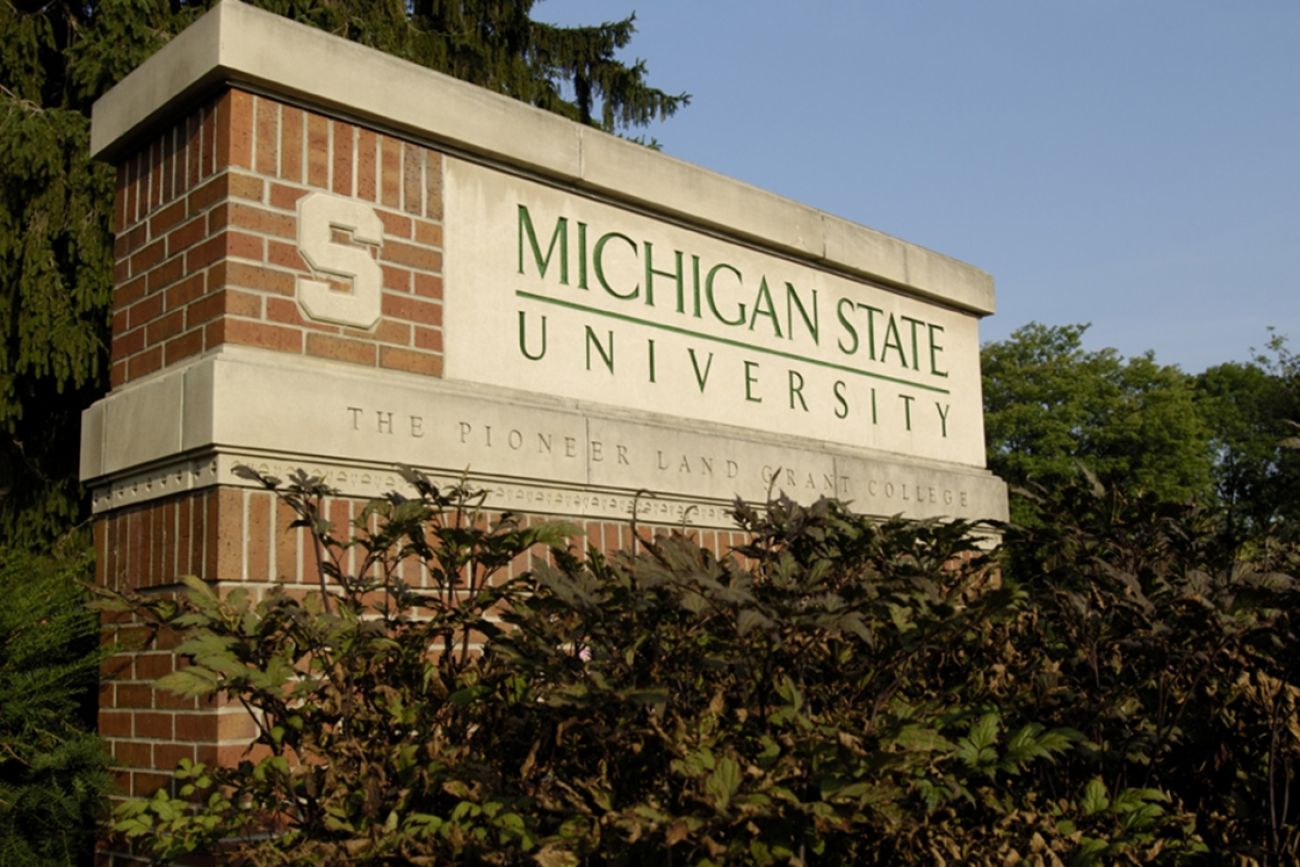MSU called out on COVID cases, and warned football game may be at risk

More than 1,250 cases of COVID-19 have been confirmed at Michigan State University since Aug. 24 — more than double the 499 that the university reports on its coronavirus tracker web page, according to the county’s top health official.
Linda Vail, Ingham County health officer, expressed frustration that MSU is not including county numbers in its case counts. She added that if MSU’s scheduled opening football game Oct. 24 were held now, she would “absolutely tell them to call it off,” given the current volume of COVID cases on campus.
“I'm always eternally optimistic that the trend is going down, and by next week maybe things will be better instead of worse,” she said.
However, she added, “I will not be hesitant — if our numbers are still [at] levels that I'm incredibly uncomfortable with — with letting the university know that's not something that I can support at this point in time.”
[After this article was published Tuesday evening, Vail contacted Bridge to clarify that she did not mean to suggest she would order the game’s cancellation if case numbers remain high. Instead, she said, she meant to convey she would “advise” that the game be canceled.]
Related stories:
- Michigan State, U-M change reporting to disclose more campus COVID cases
- COVID triples in Michigan K-12 schools, rises 60% at colleges in a week
- Coronavirus outbreaks force mandatory quarantine at 23 MSU frats, sororities
- Grand Valley State students ordered to stay home to tamp down COVID-19 upswing
MSU spokesperson Emily Guerrant told Bridge Michigan on Tuesday she does not know what the university would do if the county health department recommended shutting down a football game, or if Vail has the authority to order a game canceled.
Vail offered the caution about football during a Tuesday virtual news conference, in which she expressed frustration with MSU for reporting far fewer coronavirus cases on its website than the MSU-related COVID count known by the county health department
Vail said she has repeatedly provided the university with county case data, but MSU’s response is that the data — handed over without names or personal identifiers to protect health privacy — can’t be verified as students or confirmed to be connected to the university.
Yet those same individuals have told health department contact tracers they are students, Vail said.
“I'm not making up numbers. I'm not throwing in extra numbers that just kind of look like they might be an MSU student … We are being told that information by the individuals, themselves,” she said.
County health officials consider cases MSU-related if they are students, faculty or staff of the university. Fewer than 50 “secondary” cases — cases of a parent or sibling that is infected, for example — have been reported but are not included in Ingham County’s count of MSU-related cases, Vail said.
According to MSU’s website, the university reports a total of 499 confirmed COVID-19 cases as of Tuesday among students and staff since Aug. 24. The website acknowledges the data include only cases in which students or staff are tested at campus facilities, and positive test results that are self-reported to the university by students or staff members.
MSU’s Guerrant said the university does not dispute the health department’s tally. She said people looking for “what’s happening in the community” should look at Ingham County Health Department’s website; the MSU website provides only information that school officials themselves can confirm.
But the university’s website says its public-facing count of coronavirus cases includes cases self-reported by students and staff, as well as “cases the university becomes aware of through campus testing or local health departments.”
That phrasing could give students, faculty and the public the incorrect impression that the coronavirus case numbers reported by MSU include health department data.
Vail said in a virtual news conference Tuesday that MSU-related case data are sent to the university.
It is the county health department that is notified of positive tests by testing labs or health care providers. And it is the health department that then conducts contact tracing to alert others who may have been in contact with infected people.
“I’m like, you either need to take off the fact that you're getting that information from local health departments or you have to take my numbers,” Vail said.
At the same time, Vail lauded the university’s efforts to keep students safe and their work with the health department: “We work very well together. They have been amazing partners,” she said.
The conflicting case counts at MSU are the latest example of the uneven reporting of COVID cases at Michigan colleges and K-12 schools amid a deadly pandemic. As Bridge Michigan has reported, colleges and universities in the state are allowed to enact their own reporting policies, a patchwork approach that mirrors reporting disparities at K-12 schools this fall.
Michigan State closed its residence halls and moved virtually all its classes online in August, just days before students were to move into dorms in East Lansing, in an effort to lower the number of students on or near campus..
But an estimated 38,000 MSU students live off-campus, with most of them locked in leases for the 2020-21 school year even before the pandemic struck Michigan in March. On Aug. 18, the health department banned any outdoor gatherings of more than 25 people in East Lansing areas associated with the university.
On Sept. 12, concerned by a rapid coronavirus spike, Ingham County health officials recommended all MSU students living in East Lansing self-quarantine for 14 days. The quarantine wasn’t mandatory.
Two days later, the health department ordered a mandatory quarantine at 30 fraternities, sororities and large off-campus student houses; an order that was expanded to 11 additional off-campus houses on Sept. 18.
Students and staff are required to wear masks when on campus, and East Lansing officials have mandated masks in the downtown business area around the campus.
Vail said the health department and school have not been able to agree on data, even as the gap between their numbers grows wider.
“And that is going to call into question: What’s going on at the university?” she said.
The issue again underscores the varying levels of transparency and the troublesome nature of data involving both college and K-12 schools across the state. As students have filed into classrooms again or switched to online learning, school-related outbreak data has been spotty at best.
As of Sept. 17, there were state-confirmed coronavirus outbreaks reported on 20 Michigan college campuses and 28 K-12 schools, according to a state report released Monday.
That report, too, though, is assumed to be an undercount, according to state officials.

For Vail’s part, she has been raising concerns about a surge in cases in East Lansing since students began moving back to East Lansing.
Vail said Tuesday she worries about anecdotal reports that some students might forgo testing, even if they’re sick, to avoid contact tracers or a quarantine order.
“I kind of feel like I’m running out of tools in my toolbox,” she said, though she also noted that health officials in Ottawa County last week ordered Grand Valley State University students to shelter in place except for school, certain work obligations, and emergencies.
With MSU’s football team scheduled to open Big Ten play Oct. 24 at home against Rutgers, Vail said authorities will watch for large parties and other opportunities for continued COVID spread.
“The university has said that there will be no tailgating and parties on campus and they will have to enforce that,” she said.
She said she’s happy that athletes will be tested regularly, and she noted bars and restaurants are limited in how many patrons they can serve and still follow safety protocols.
Told of Vail’s comments on football, MSU’s Guerrant said she was unaware Vail had suggested football games should be cancelled if coronavirus counts don’t decline before the season starts in a month.
Guerrant said she didn’t know if a health official could shut down a game.
Under Michigan’s public health code, local health officials appear to have emergency authority to limit crowds during an epidemic “if a local health officer determines that control of an epidemic is necessary to protect the public health.”
“We value Linda’s input,” Guerrant said. “In a pandemic, a local health official has a lot of power, but I honestly don’t know when it comes to a football gathering."
Editor's note: The Ingham County Health Department may advise Michigan State University not to play football on Oct. 24 if COVID-19 levels on campus remain at current levels. The article was changed on Sept. 22, 2020, after Ingham County Health Officer Linda Vail clarified she would "advise" the university not to play the game. rather than order its cancellation.
Michigan Education Watch
Michigan Education Watch is made possible by generous financial support from:
Subscribe to Michigan Education Watch
See what new members are saying about why they donated to Bridge Michigan:
- “In order for this information to be accurate and unbiased it must be underwritten by its readers, not by special interests.” - Larry S.
- “Not many other media sources report on the topics Bridge does.” - Susan B.
- “Your journalism is outstanding and rare these days.” - Mark S.
If you want to ensure the future of nonpartisan, nonprofit Michigan journalism, please become a member today. You, too, will be asked why you donated and maybe we'll feature your quote next time!





